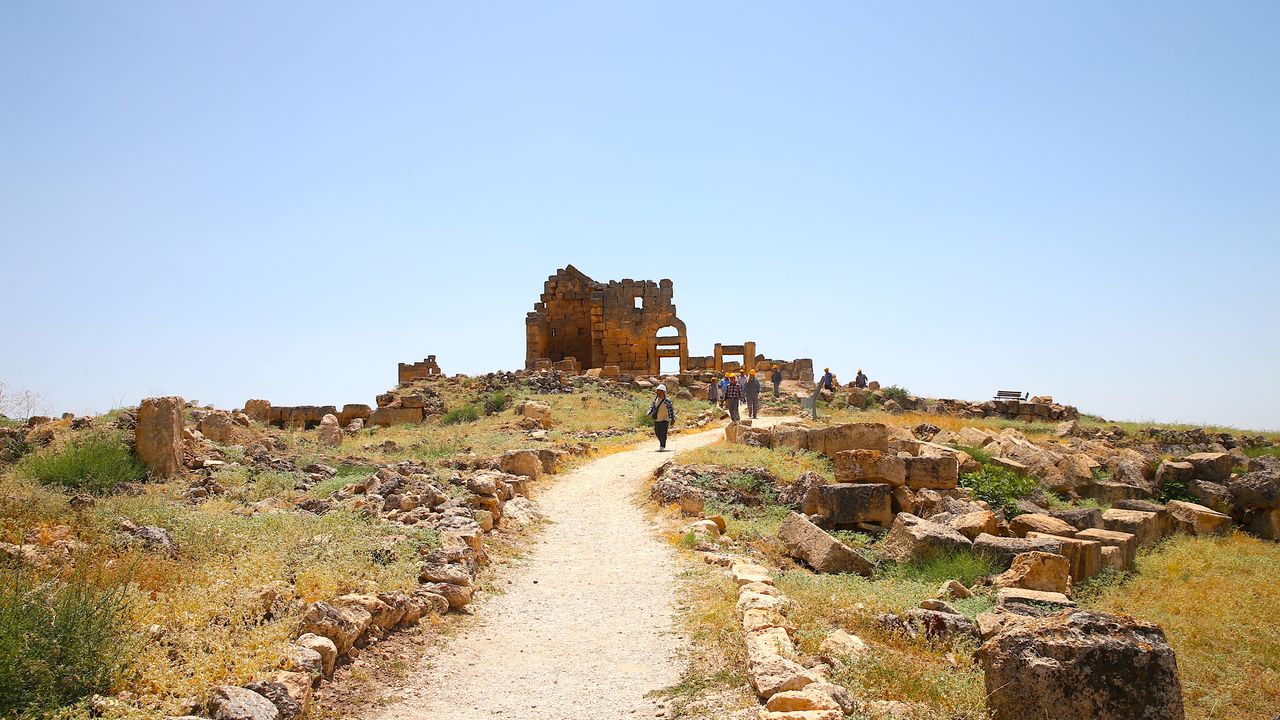AMED TIMES- During excavation work at Zerzevan Castle in the Çınar district of Diyarbakır, a room was found where participants in secret rituals used to stay.
Zerzevan Castle, which is located near the village of Demirölçek, 13 kilometers away, was used as a "military settlement" during the Roman Empire and is one of the city's most important tourist attractions.
In the military settlement, where the last Mithras temple in the world was excavated, the castle sheds light on history through scientific excavations.
The excavation work started in 2014 in the historical castle, which is on the UNESCO World Heritage Tentative List, continues with the support of the Ministry of Culture and Tourism, the Governor's Office, Diyarbakır Museum, Çınar District Governor's Office and Dicle College.

So far, remains of 12-15 meter high and 1200 meter long walls on an area of 60 hectares, a 21 meter high watchtower, a church, an administrative building, residential buildings, grain and weapon depots, rock tombs, water channels and 54 water cisterns, an underground church, an underground shelter that could hold 400 people, residential buildings and secret passages as well as an underground Mithras temple, which reached its importance in the 4th century BC, have been discovered.
This year's excavations have uncovered the area where the guests who came to the Mithras temple for secret religious ceremonies spent the night.
The last sacred area of Mithras in the world
The head of the excavations, Assoc. Prof. Aytaç Coşkun, explained that the excavation works in Zerzevan Castle began 10 years ago and will continue this year in the most important area of the castle, the sacred area of Mithras.
Coşkun noted that the sacred area of Mithras was discovered by chance in 2017 and that they did not know that there was a structure belonging to the Mithras faith when they started the excavations in this area.
Coşkun emphasized that this was a very significant discovery:
"Because it is the first sacred area on the eastern border of the Roman Empire. It is the last Mithras sanctuary in the world. Mithras is the esoteric and mysterious faith of the Roman Empire. Its ceremonies and rituals are secret. All these secret ceremonies and rituals are performed in the underground structures and temples of Zerzevan Castle. During the excavations, we have found the places where the followers of 'Mithras' stayed, who came from different parts of the Roman Empire at certain times of the year and belonged to the esoteric faith. We are continuing the excavations in this area. We will present the results to the scientific world."
"Visitors from all countries come to see the sacred area"
Coşkun recalled that a temple, an underground structure and a monumental entrance belonging to the Mithras faith have already been found at the historical castle and pointed out that the most important structure of Zerzevan Castle is the sacred area of Mithras.
Coşkun emphasized that they have obtained information about this mysterious faith, for which there are no written documents, through the excavations here and presented it to the scientific world and said that they plan to complete the work in the accommodation area by the end of the year.
Coşkun said,
We are looking forward to finding the places where Mithras followers from different parts of the Roman Empire came to participate in the secret ceremonies and rituals in the 1900-year-old sacred area of Mithras. We have focused our efforts on this area, which is the most curious part of Zerzevan Castle."

Explained Coşkun:
"There are visitors from all countries, especially from the USA, England, Switzerland, Japan and Russia, who want to visit the Mithras sanctuary. The visitors who come here want to see the area where the oldest esoteric faith in the Roman Empire was practiced. This is very important for tourism in the region and the country."
Zerzevan Castle and Mithras Temple
The military settlement of Zerzevan Castle, which is situated on a 124-meter-high rock on the old road route, is strategically located between Amida and Dara.
The castle, which dominated the entire valley due to its location on the old trade route, controlled a huge area. The castle, a Roman border garrison, witnessed major battles between the Romans and the Sassanids.
The settlement, which dates back to the Assyrian period (882-611 BC), was built in the 3rd century AD during the Roman period mainly as a military settlement and was used continuously until the conquest by Islamic armies in 639.
The walls and structures of the settlement were repaired during the reigns of Anastasios I (491-518 AD) and Justinianos I (527-565 AD) and partially rebuilt in their current form.

The temple of Mithras, which is located to the north of Zerzevan Castle, was built by carving the main rock into the ground. On the east wall of the building there are columns carved into the main rock, a large niche in the middle and two smaller niches on the sides.
"Mithras" is known as the sun god and was quite widespread in the Roman Empire in the 2nd and 3rd centuries AD as a symbol of light, war, justice and faith, and became a symbol of the sun in the 4th century AD.

The mystery religion of Mithras spread among soldiers, merchants and aristocrats in all areas under Roman rule.
Its religious ceremonies are secret and completely closed to outsiders. Only men were accepted into this religion and participants went through seven stages. The ceremonies were held underground in caves or temples.
